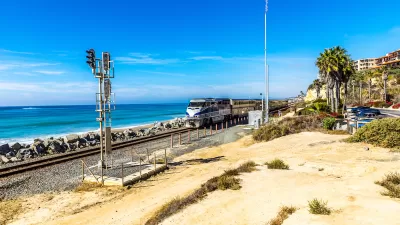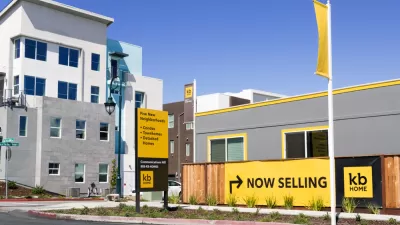Transit oriented development is on the rise in California, with new projects being pushed in conjunction with new rail lines in Southern California and the Bay Area.
The Architect's Newspaper provides a detailed rundown of the transit oriented development projects recently completed or in the works in the state.
"Thanks to changes in both attitude and development patterns, the growth in transit is bringing with it a lengthy list of Transit Oriented Developments (TODs), projects catering to a combination of mass transit, denser neighborhoods, and mixed-use and pedestrian scale development. And the leaders in TOD are none other than local transit agencies themselves, taking matters into their own hands by making huge investments, often in coordination with the field's other players: developers, non-profits, and redevelopment agencies. In addition to several transit authorities along the path of California's high speed rail, the leading agencies are LA County Metropolitan Transit Authority (Metro) and Bay Area Rapid Transit (BART). "The public sector creates infrastructure, the private sector creates development. That creates harmony," sums up Ronald Altoon, a partner at architecture firm Altoon + Porter and incoming Executive Director at the Urban Land Institute's LA Chapter."
FULL STORY: Feature> Home on the Rails

Manufactured Crisis: Losing the Nation’s Largest Source of Unsubsidized Affordable Housing
Manufactured housing communities have long been an affordable housing option for millions of people living in the U.S., but that affordability is disappearing rapidly. How did we get here?

Americans May Be Stuck — But Why?
Americans are moving a lot less than they once did, and that is a problem. While Yoni Applebaum, in his highly-publicized article Stuck, gets the reasons badly wrong, it's still important to ask: why are we moving so much less than before?

Using Old Oil and Gas Wells for Green Energy Storage
Penn State researchers have found that repurposing abandoned oil and gas wells for geothermal-assisted compressed-air energy storage can boost efficiency, reduce environmental risks, and support clean energy and job transitions.

Greening Oakland’s School Grounds
With help from community partners like the Trust for Public Land, Oakland Unified School District is turning barren, asphalt-covered schoolyards into vibrant, green spaces that support outdoor learning, play, and student well-being.

California Governor Suspends CEQA Reviews for Utilities in Fire Areas
Utility restoration efforts in areas affected by the January wildfires in Los Angeles will be exempt from environmental regulations to speed up the rebuilding of essential infrastructure.

Native American Communities Prepare to Lead on Environmental Stewardship
In the face of federal threats to public lands and conservation efforts, indigenous groups continue to model nature-centered conservation efforts.
Urban Design for Planners 1: Software Tools
This six-course series explores essential urban design concepts using open source software and equips planners with the tools they need to participate fully in the urban design process.
Planning for Universal Design
Learn the tools for implementing Universal Design in planning regulations.
Heyer Gruel & Associates PA
City of Moreno Valley
Institute for Housing and Urban Development Studies (IHS)
City of Grandview
Harvard GSD Executive Education
Salt Lake City
NYU Wagner Graduate School of Public Service
City of Cambridge, Maryland





























